Grocery Guides
Salsas: FAQs on Fresh Salsa, Store-Bought, Canned & More!
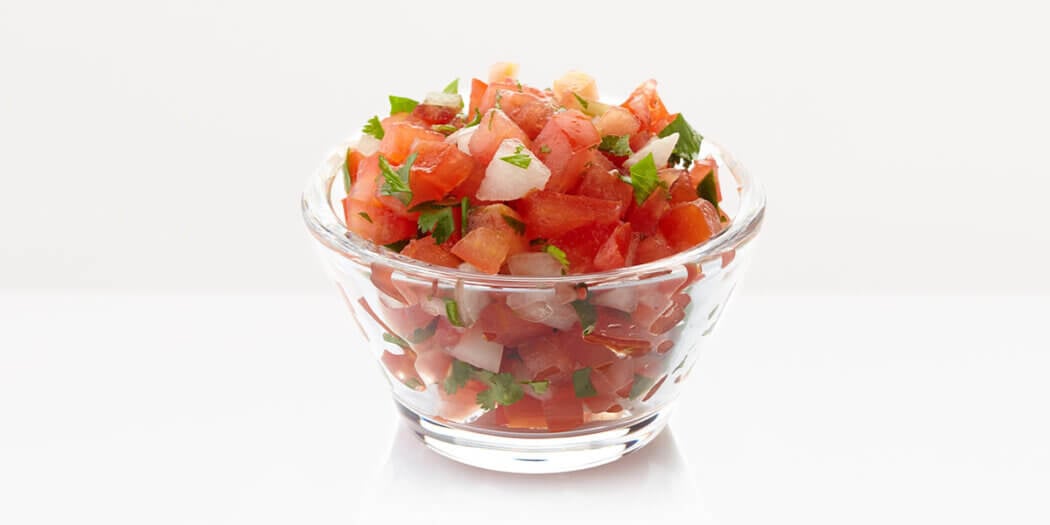
What is salsa?
Salsa is Spanish for sauce. It is often thought of as a condiment made of tomatoes, onions, and chilies. However, salsa comprises various sauces used as condiments for Mexican and Mexican-inspired foods such as tacos, tamales, and nachos. Salsas are also used as dips for tortilla chips.
What is fresh salsa and how is it different from other salsa?
This simple dip, such as Pico de Gallo, is made from finely chopped fresh produce that hasn’t been cooked. The ingredients typically include tomatoes, peppers, onions, lime juice, and spices. Some fresh salsa also contains fruit, like peaches or mangos. They may even contain black beans and/or corn.
Unlike other types of salsas, fresh salsas have very little liquid. This makes them great for topping quesadillas, tacos, and other Mexican and Latin-inspired foods.
Where did salsa originate from?
Salsas can be traced back to central American civilizations such as the Aztecs, Incans, and Mayans long before the Spaniards crossed the Atlantic to conquer the Americas in the 1500s. It became popular in Spanish culture, and the dish was officially named “salsa” by Alonso de Molina in 1571.
In the 1980s, Mexican restaurants in the United States popularized salsas as a table dip. However, the sauce originally made its way across the border from Mexico in the early 1800s.
How is salsa made?
Salsa is most often made with three primary ingredients—tomatoes (or tomatillos), onions, and chilies. Additionally, spices, citrus, and fresh herbs like cilantro (coriander leaves) and parsley may be added. Buy cilantro. These are then cooked and blended. Check out an easy salsa recipe here.
You can use other ingredients to make the salsa too. For example, avocado, corn, mango, papaya, and plantains. Shop avocado. Depending on the type and amount of chili used, salsas can range from fresh and tart to hot and spicy.
Fresh salsas are even easier to make! It simply requires choosing the right mix of produce, chopping it up into small chunks, and mixing it with lime juice and spices. A basic recipe may include fresh tomatoes, diced red onion, jalapeno peppers, lime juice, cilantro, dried oregano, cumin, salt, and pepper.
The beauty of fresh salsas is that they are very versatile. You can easily substitute ingredients to make unique flavors.
Different types of salsa
Fresh salsas (salsa fresca or salsa cruda) are made with tomatillos, green chilies, lime juice, and spices. Cooked salsas usually comprise roasted tomatoes, fresh or dried red chilies, onion, and spices. Salsas range from chunky to smooth, processed sauces.
- Salsa verde, or green salsa, is usually made from pureed tomatillos, cilantro, and green chilies.
- Salsa roja, or red salsa, usually comprises cooked red tomatoes, red chili peppers, and onions.
- Pico de Gallo is a fresh salsa. It is usually made from coarsely chopped tomatoes, onions, and cilantro, and dressed with freshly squeezed lime juice. Shop fresh pico de Gallo.
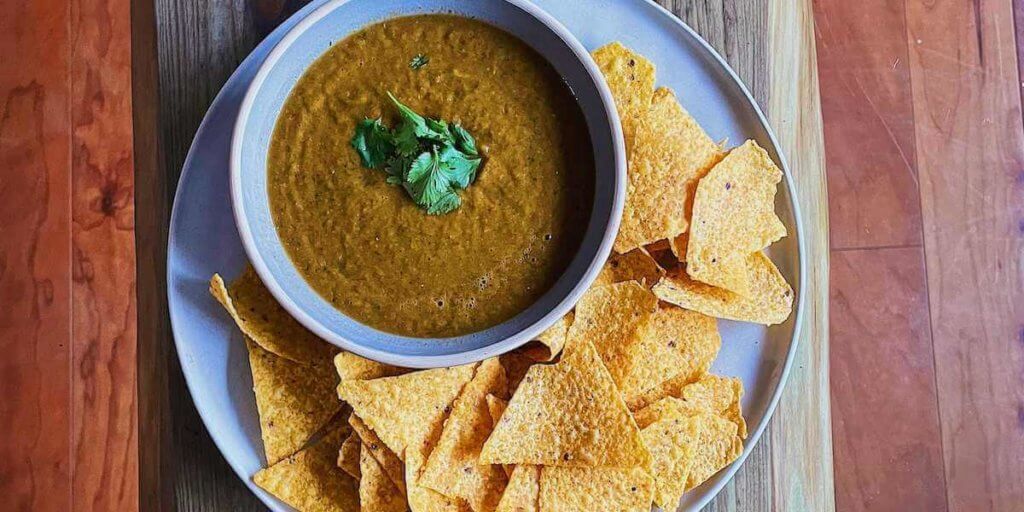
Is salsa healthy? Minerals and benefits:
As far as condiments go, salsa is a healthy option. It is low in fats and, depending on how it is made, can be low in sugars as well. In addition, onions, tomatoes, and chilies all have healthful essential nutrients beneficial to your diet.
Fresh salsas can be a delicious, low-calorie addition to your meals, and they also offer many other benefits. Fresh salsa is packed with vitamin C, lycopene, and potassium. Since tomatoes are mostly made up of water, fresh salsas are hydrating. They’re also high in fiber.
Where to find salsa?
Searching for salsa in the supermarket isles? There are two different areas where you might find salsas. Freshly prepared salsas could be in the refrigerated food section. Shelf-stable salsas may be on the chip aisle or in the condiments section.
How do you choose salsa at the grocery store?
Don’t have time to make your own salsa? There are so many store-bought options to choose from. But, how do you pick salsa at the supermarket? The first question you have to ask yourself is: “What am I going to serve the salsa with?” If you are buying salsa as a dip for tortilla chips, you might want a sauce with a smoother consistency. But, if you are looking for a salsa topping for your nachos, you might lean towards a chunkier option.
Read the jar carefully to make sure that you are buying a sauce that matches your tolerance for chili. Most shelf-stable salsas have mild to medium heat. However, there will also be plenty of salsas to choose from with a bigger hit of heat for chili-lovers. If you are not sure where you stand on the spice spectrum, start off with mild salsa and work your way up the Scoville scale. Shop mild salsa.
Another point to consider: do you want a fresh salsa or a cooked, shelf-stable salsa. A fresh salsa might pack more flavor but won’t last as long if you don’t plan to use it all right away. Once opened, a shelf-stable salsa may keep for one or two months if stored correctly. Shop fresh salsa.
If you are looking to have your groceries delivered, you can easily shop for salsa via Instacart. After adding a product to your cart, use the “Instructions” option to notify your Instacart shopper about any preferences or specific directions on how to choose the best products. Shop for salsa.
When are fresh salsas in season?
If you search “fresh salsas near me,” you can find store-bought versions at any time of the year. However, if you want to enjoy fresh salsa at its peak, you can make it at home with in-season produce. Since tomatoes are the primary ingredient, salsa will be freshest when they’re in season – typically May through October (depending on where you live).
Grab it now on Instacart:
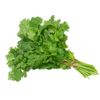

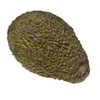


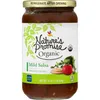

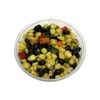

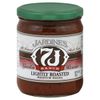

How to store salsa
Like many other fresh dips and spreads, it’s best to store fresh salsas in the refrigerator. If you have made your own fresh salsa, store it in a well-sealed jar in the refrigerator for up to one week. You can also freeze your homemade salsa. In a well-sealed container, salsa should keep for about six months in the freezer. If you’re not going to use all of your store-bought fresh salsa at once, plan to keep what’s left in the original container rather than transferring it to another dish. The original packaging is often designed to preserve the salsa, giving you the best results.
As a general rule of thumb, as long as they’re covered and adequately refrigerated, you can expect fresh salsas to stay good for about five days after they have been opened. If a container of store-bought fresh salsa hasn’t been opened, check the “use by” date on the container to determine its freshness.
How to tell if salsa is bad
It’s fairly easy to tell if your fresh salsa has gone bad. You might notice that the color has changed or the smell is off. When salsa has gone bad, it will often take on a darker, maroon-like color and become mushy. If your fresh salsa smells rotten or you notice mold, throw it in the trash right away. If the salsa has an offensive odor or strong sour taste, it has likely past its prime. In addition, if the salsa has a yeasty smell and is fizzy on the palate, it has started fermenting and is not suitable for consumption.
What can I substitute for salsa?
If you don’t have fresh tomatoes, you can make homemade salsas with canned tomatoes. Substitute chili powder or chili flakes for fresh chilies if needed.
If you don’t have the ingredients to make fresh salsa, you can use pre-made salsa—either fresh, canned, or jarred. Unfortunately, there are not many things that you can substitute for salsa. In a pinch, you could use pasta sauce instead. However, the flavor profile and herbs used will be different.
The drawback of using jarred salsas is that they don’t have the same fresh flavor. If you want the taste of fresh salsa, consider making it yourself. You can set up a produce delivery for all of the ingredients, then chop them up and mix them. Then, store your homemade fresh salsa in the refrigerator until you’re ready to serve it.
A salsa for any occasion
Whether you want to buy ready-made salsa or the ingredients for making your own salsa, get everything you need by shopping online. Browse Instacart for salsas and salsa ingredients at local or national retailers near you.
Most Recent in Grocery Guides

Grocery Guides
Guide to Sustainable Grocery Delivery
Who has time for the grocery store these days? Between work, family and everything else, it feels like a chore we could all do without. That's where sustainable grocery delivery comes in! You get the…
Feb 7, 2025
Grocery Guides
19 Best Milk Substitutes for Baking and Cooking
Milk’s rich texture and neutral flavor make it a staple in countless recipes, bringing creaminess and balance to sweet and savory dishes alike. But what happens if you run out of milk or need a…
Jan 30, 2025
Grocery Guides
15 Best Cheeses for Your Next Charcuterie Board
Let’s face it: The heyday of the store-bought party platter is long gone. Now, the duties of a good host often include curating an impressive charcuterie board. But where do you begin? Charcuterie boards typically…
Jan 21, 2025

 Squash – All You Need to Know | Instacart Guide to Fresh Produce
Squash – All You Need to Know | Instacart Guide to Fresh Produce  Ghost Pepper – All You Need to Know | Instacart Guide to Fresh Produce
Ghost Pepper – All You Need to Know | Instacart Guide to Fresh Produce  Sprouts – All You Need to Know | Instacart Guide to Fresh Produce
Sprouts – All You Need to Know | Instacart Guide to Fresh Produce 

